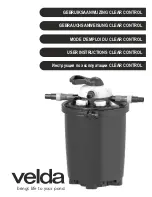
SERVICE MANUAL
FAN PSS 1-2 ENGL-DEUT MAI 2009_NEU
PAGE 26 OF 45
4.2.3
Appraisal factors for Auger and Screens
of wear and refurbishing
All the moving parts of the PSS are subject to wear.
Some of the parts that are subject to wear and need to
be maintained were identified previously. Proper
maintenance and periodic monitoring of the wear parts
are essential in prolonging the “normal” life of the PSS.
Worn-out parts should be replaced as soon as possible.
The wear parts that directly affect the normal operation
of the PSS are the screen and the auger.
In principle, only the auger can be refurbished.
Currently, the refurbishment of the screen is impossible.
The auger can be properly refurbished, but only by a
company authorized by FAN Separator to meet the
necessary standards.
Do not use other manufacturers for the refurbishing
of old augers, as the screen may be damaged if the
flights do not match the designed tolerances,
thereby forfeiting the warranty.
Figure 4.6 showed appraisal factors for the wear of the
screen.
The normal wear of the screen corresponds with the
enlargement of the inner screen diameter and an
increase of the slot size as a result of the rod-geometry
of the screen. Generally, the wear of screen and auger
also affect the normal operation of the PSS. For
example, assuming no change in influent, lower flow-
rate, worse effluent, etc., indicates improper wear.
The wear of screen and of the outer edges of the flights
of the auger change the spacing configuration. That is,
with new conditions the radial space between screen
and auger is nearly the same as the slot size of the
screen and can be measured with a feeler gauge
shown in Figure 4.12.
If the radial gap between screen and auger reach
values of two times of the slot size or higher, direct
influences to the normal operation condition of the PSS
will be observed and there is a greater risk of damage
to the screen. In general, the auger has to be
refurbished if the radial gap between a new screen and
auger exceed twice the slot size of the screen.
The most important criteria for the radial wear of the
screen and auger is the operation condition of the
machine. Namely, if the operation results (flow rate,
quality of the effluent, etc.) differ from the “normal”
operation, then this is an important indication that the
screen must be changed or the auger refurbished.
Further indications for the necessity of the auger
refurbishment is the appearance of the hard facing as
shown in Figure 4.13.
In principle, the auger has to be refurbished before the
4.2.3
Beurteilungskriterien für Schnecke und
Siebe hinsichtlich Verschleiß und
Wiederaufarbeitung
Alle bewegten Teile am PSS unterliegen mehr oder
weniger dem Verschleiß. Einige der direkt vom
Verschleiß betroffenen und damit regelmäßig zu
inspizierenden Teile wurden bereits angesprochen.
Eine gute, regelmäßige Inspektion und Wartung der
Verschleißteile führt zu einer wesentlichen
Verlängerung der Standzeit. Verschlissene Bauteile
sollten dabei so schnell wie möglich ausgetauscht
werden, um sonst entstehende Folgeschäden zu
vermeiden.
Die den Betrieb des PSS direkt beeinflussenden
Bauteile sind das Sieb und die Schnecke. Unabhängig
davon wird der „normale“ Betriebszustand des PSS
aber auch von anderen Parametern als nur durch den
Verschleiß beeinflusst.
Grundsätzlich kann nur die Schnecke wieder
aufgearbeitet werden, eine Aufarbeitung des Siebes ist
generell nicht möglich.
Die Wiederaufarbeitung der Schnecke darf nur durch
einen von FAN Separator GmbH zugelassenen Betrieb
durchgeführt werden, um die notwendige Qualität und
Genauigkeit sicherzustellen.
Beauftragen Sie nie einen anderen Hersteller, die
Schnecke wieder aufzuarbeiten, da bei nicht
korrekter Ausführung in den erforderlichen
Toleranzen das Sieb zerstört werden kann und
jegliche Garantieansprüche entfallen.
In Abb. 4.6 wurde bereits aufgezeigt, wie das Sieb
hinsichtlich Verschleiß beurteilt werden kann.
Der normale Verschleiß des Siebes geht einher mit
einer Vergrößerung des Innendurchmessers als auch
mit einer Vergrößerung der Siebspaltweite aufgrund der
Geometrie der Siebdrähte. Der Verschleiß von Sieb
und Schnecke geht in der Regel ebenso einher mit
einer Beeinflussung des „normalen“ Betriebes, d.h.
Reduzierung des Durchsatzes, schlechteres Effluent
usw., natürlich unter der Voraussetzung, dass sich das
Medium und die Konsistenz nicht verändert hat.
Ein Verschleiß des Siebes oder der Schnecke an den
Aussenkanten der Flügel verändert den Arbeitsspalt. Im
Neuzustand ist der Arbeitsspalt und damit der radiale
Spalt zwischen Sieb und Schnecke näherungsweise
der Spaltweite des eingesetzten Siebes und kann
mittels einer Fühlerlehre, wie in Abb. 4.12 dargestellt
ermittelt werden.
Erreicht der radiale Spalt zwischen Sieb und Schnecke
die zweifache Siebspaltweite oder höher so wird nicht
nur der normale Betriebszustand beeinflusst, sondern
es besteht ebenso die Gefahr, dass das Sieb platzt,
bzw. das Sieb beschädigt wird. Ist der radiale Spalt
zwischen Sieb und Schnecke auch nach dem
Austausch gegen ein neues Sieb größer als die
zweifache Siebspaltweite, so muss die Schnecke
aufgearbeitet werden. Das wichtigste Kriterium für den
















































